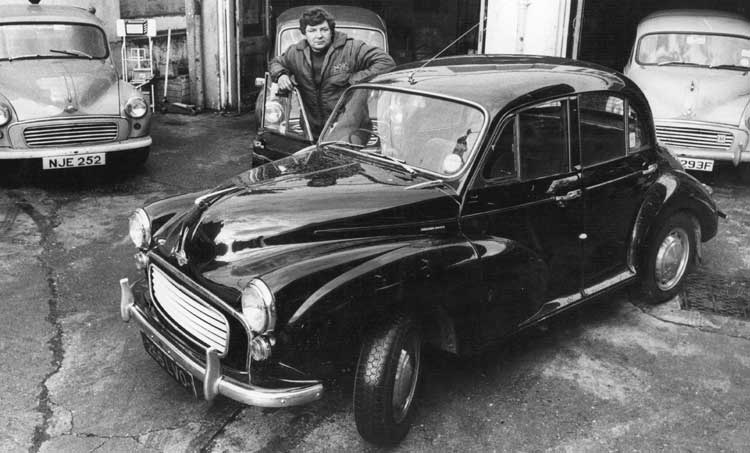Morris Minor
Rather like Doctor Who's tardis, it travels through time pretty well, writes Giles Chapman

As an everyday car, the Morris Minor makes sense. Unlike most classic cars, you can keep a Minor running indefinitely. Every component you will ever need is cheap and plentiful. That's why Minors are still so ubiquitous and possibly - to many enthusiasts who thrive on the battle to keep their cars alive - a bit too predictable. After all, they're not fast and they're definitely not sexy.
As an everyday car, the Morris Minor makes sense. Unlike most classic cars, you can keep a Minor running indefinitely. Every component you will ever need is cheap and plentiful. That's why Minors are still so ubiquitous and possibly - to many enthusiasts who thrive on the battle to keep their cars alive - a bit too predictable. After all, they're not fast and they're definitely not sexy.
Still, in 1948, the box-fresh, £358 Morris Minor was an economy car that drove, steered and handled outstandingly yet was still roomy, affordable and economical. Not everyone was impressed, though - company founder William Morris, by then Lord Nuffield, was appalled at a car resembling, in his own words, "a poached egg".
However, the sour old duffer had to eat his words when production of the Morris Minor reached one million - the first British car to do so, at which 350 celebratory limited editions were made with lilac paintwork and white seats - in 1959. He had the good grace to thank the designer, Alec Issigonis, for creating a motoring institiution, but no inkling Issigonis would trump even the Minor's popularity with his Mini.
When he envisioned the Minor during the Second World War, Issigonis saw no reason such a small car couldn't drive and handle well. So he moved the engine for a better centre of gravity, specified rack and pinion steering, and designed torsion bar independent front suspension, which gave the Minor a less jarring ride than rivals. Nuffield's accountants vetoed his plan for the system at the back - too costly. So he had to stick with an old-fashioned live axle located by leaf springs with lever-arm dampers.
The design was virtually signed-off in 1947, when Issigonis suddenly decided the car was too narrow. He halted all development work while he sawed one of the prototypes in half from nose to tail to insert four more inches of width. That's why the crest of the car's roof running front to back is completely flat.
One throwback to older Morris cars was the 918cc sidevalve, four-cylinder, 27.5bhp engine, which meant the Minor huffed and puffed to its maximum speed of just 60mph.
Most of these first cars, the Minor MM-type saloons and convertibles, were exported, so British demand was pent-up for them. In 1950, the headlamps were moved from the grille to high up on the front wings, to satisfy American lighting rules. Ironically, this was just when transatlantic sales collapsed because Americans found it gutless and flimsy.
Also in 1950, a four-door saloon was announced, the two-door Traveller estate following in 1953, by which time the car had gained the 803cc overhead valve engine from Morris's new British Motor Corporation stablemate, the Austin A30.
In 1956, the Minor's divided windscreen was replaced by a one-piece, and its engine size boosted to 948cc to become the Morris Minor 1000. In 1962, the engine upped again, to 1098cc.
When designing the commodious Traveller, Alec Issigonis showed a remarkable ability to work with wood. He devised the rear of the car as a timber structure, cladding the frame with aluminium panels. Along with van-like doors and flat glass, the rump of a Traveller fitted together with Lego-like ease. This is the upside for DIY restorers faced with the otherwise laborious task of trying to eradicate rot, woodworm and mobile flora from Travellers.
The Minor lingered on until 1972 when the last one, a Traveller, was made at Cowley, Oxfordshire. It eventually sold 1,583,619 units. By the end, it was the motor industry equivalent of a Chelsea pensioner.
Charles Ware, founder 28 years ago of the Morris Minor Centre in Bath (www.morrisminor.co.uk, tel: 01225 315449) thinks about 65,000 Morris Minors are still on British roads.
"We can supply 99.5 per cent of the parts you need to build a Minor from scratch," he says. "We have really been responsible for the car's survival in Britain. They're emotive cars, people don't want to lose them." Yet Ware says he's happy when customers spend only what's necessary. "The great thing is you can keep using it while you do it up bit by bit," he explains.
For instance, there are 80 structural body parts in a Minor Traveller and the Morris Minor Centre supplies them all. Many are made at a pioneering open-air factory in Sri Lanka.
"And besides ourselves," says Ware generously, "there are about 20 one-man-band specialists up and down the country looking after owners."
And the driving? Minors are sedate performers, but the car more than makes up for this with excellent ride and beautifully light, responsive steering.
You will also delight in its details: the indicator stalk with a flashing green light on the end, the central speedo and that comforting, flatulent noise when you change gear - caused not by any engine ailment but by the shape or bore of the exhaust. Even Mr Ware wasn't sure which.
What to pay for a Minor today? Decent examples for about £2,500, rising to £6,500 for a pristine Traveller or convertible. You can spend £14,000 creating a new one from scratch, but old heaps still start at £50.
Subscribe to Independent Premium to bookmark this article
Want to bookmark your favourite articles and stories to read or reference later? Start your Independent Premium subscription today.

Join our commenting forum
Join thought-provoking conversations, follow other Independent readers and see their replies